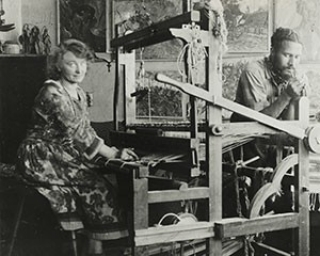Born 1901, Florence, South Carolina
Died 1970, Central Islip, New York
Born in a small South Carolina town, William H. Johnson left for New York at seventeen and enrolled at the National Academy of Design in 1921. Though he originally intended to become a cartoonist, he won acclaim as a painter, leading to a year of independent study in Paris in 1926. He remained abroad, moving to the south of France and later traveling throughout Europe with his wife, the Danish artist Holcha Krake. He gained critical recognition and commercial success before the couple returned to New York at the onset of World War II. Under the auspices of the WPA, Johnson found employment teaching art in Harlem, where the neighborhood and its artistic community inspired him to change the style and subjects of his paintings.
Prior to 1938 Johnson was known for his expressionist landscapes and portraits. Upon returning to New York, he adopted a self-consciously vernacular style marked by vivid colors and flat, distorted compositions, looking to African sculpture and African American models for inspiration. His new subject matter included Harlem life, the rural south, and religious scenes as well as biting indictments of racism and celebrations of African American heroes and historical figures. This apparently drastic shift had actually been under way since the early 1930s, when the artist began to assert and cultivate his own “primitive” roots. Inspired by Krake’s involvement with traditional crafts, Johnson traveled throughout rural Scandinavia and made a pilgrimage to North Africa, incorporating these sights and experiences into his art.
Johnson’s style evolved rapidly between 1938 and 1945. Jesus and the Three Marys retains the painterly distortion of his earlier expressionism, joining it to a distinctly Afrocentric vision of a black Christ. Swing Low, Sweet Chariot takes its title from the popular spiritual, a recurrent subject for African American artists. Now using flat planes of color and simplified shapes, Johnson depicts a chorus of angels swaying rhythmically on slender magenta wings against a heated pink sky. John Brown Legend belongs to the artist’s final series, Fighters for Freedom. It depicts the martyred abolitionist in a bold, didactic manner, surrounded by blazonlike motifs.
Johnson’s grief over his wife’s tragic death in 1944, compounded by his own untreated medical issues, precipitated a mental breakdown and subsequent institutionalization. His life’s work was acquired in 1967 by the Smithsonian Institution’s National Collection of Fine Arts (now Smithsonian American Art Museum), which organized his first museum retrospective in 1971, shortly after his death.
Jenevive Nykolak
Powell, Richard J. Homecoming: The Art and Life of William H. Johnson. Washington, DC: National Museum of American Art, Smithsonian Institution, 1991.
